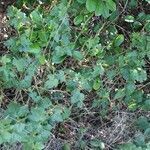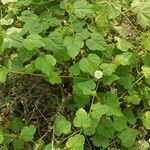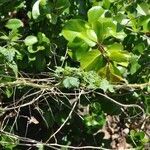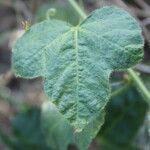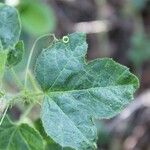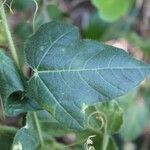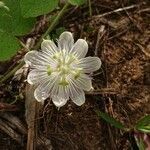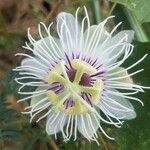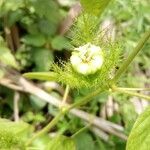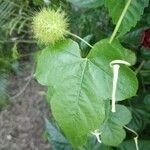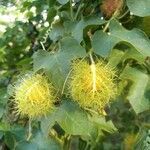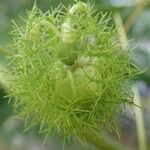Climber or creeper to 4 m, annual or biennial, subglabrous or whitish or yellowish-brown hairy to various degree; ill-odoured; stem terete. Leaves entire, or usually 3(-5)-lobed up to half-way, suborbicular to ovate in outline, 3-5-subplinerved, usually membranous, base cordate, 3-10 x 3-10 cm; lobes up to 4 cm, usually acute-acuminate, margin (sub)entire with coarser gland-tipped hairs; petiole 1-6 cm; stipules subreniform, 0.5-1 cm, deeply cleft into filiform gland-tipped processes; glands absent, except gland-tipped stronger hairs or processes on petiole, stipules, bracts, etc. Inflorescences sessile, 1(-2)-flowered, the straight peduncle 2-6 cm inserted beside a simple tendril 5-15 cm; bracts and bracteoles (1-)2-4 cm, deeply 2-4 times pinnatisect, with filiform gland-tipped segments, forming an involucre just below, and enveloping the flower. Flowers c. 3-5 cm diam., pale pinkish or lilac, rarely white; hypanthium short, saucer-shaped; sepals ovate-oblong to lanceolate, c. 1.5-2 cm, awned 2-4 mm dorsally just below the apex; petals oblong to lanceolate or ± spathulate, slightly shorter than the sepals; corona consisting of 2 outer series of threads, c. 1 cm long, several inner series of capillary threads 1-2 mm; operculum membranous, ± erect, denticulate; disc conspicuous, annular. Androgynophore 4-6 mm; filaments flattened, c. 5-6 mm; anthers 3-5 mm; ovary globose to ellipsoid, c. 2-3.5 mm, usually glabrous; styles 4-5 mm. Fruit a rather dry berry, (sub)globose, usually glabrous, 1.5-3 cm diam., yellowish to orange, ± enveloped by persistent involucre; seeds many, subovoid to ± cuneiform, c. 4-5 mm long, obscurely 3-dentate at apex.
Perennial vine to c. 9 m long, with simple axillary tendrils, covered by yellowish hairs 2–3 mm long, rarely glabrous. Stem terete, striate, slender. Stipules to 9 mm long, dissected into subulate segments, with glandular hairs. Leaves alternate, 3-lobed, rarely simple and broadly ovate or shallowly 5-lobed; lobes broadest at base, each with a single main vein; central lobe largest, triangular, acute; lamina 3–19 cm long, 4–19 cm wide, densely pubescent, with gland-tipped hairs abaxially, with glands towards the apex abaxially, base cordate, margin entire with gland-tipped hairs; petiole 3–9 cm long, lacking glands. Flowers bisexual, borne singly in leaf axils or rarely paired, 2–5.5 cm diam.; pedicels 2–8 cm long; bracts 3, 2 or 3 (4)-pinnatisect, 2–4 cm long, 2.5–3 cm wide, glabrous or with glandular hairs, with gland-tipped segments. Sepals white adaxially, green abaxially, 1–3 cm long, keeled, terminating in an awn 3–6 mm long. Petals white to purple, 1–2.5 cm long. Corona of 5–7 series of filaments; outer two series 1–2 cm long, white or with purple bases; inner series 1–3 mm long, white or with purple tips. Operculum white, often lilac at apex, membranous, 1–2 mm long. Androgynophore 5–12 mm long. Stamens 5. Styles 3 (4). Fruit an ovoid or globose berry, 1.5–4 cm diam., maturing yellow-orange or green. Seeds reticulate.
Herbaceous vines, foul smelling. Stem slender, striate, spreading pubescent. Stipules partly clasping, deeply parted, glandular pilose; petiole 2-6 cm, without glands, pubescent, indumentum dense, spreading, glandular pilose; leaf blade broadly ovate to oblong-ovate, (3-)4.5-13 × (2.5-)4-12 cm, membranous, glandular ciliate, abaxially pubescent with small nectaries in distal part, adaxially sericeous, mixed with occasional glandular hairs, base cordate, 3-lobed or unlobed, margin irregularly undulate, apex acute. Inflorescence reduced to a single flower, opposite tendril; bracts 3, 2-or 3(or 4)-pinnatifid; lobes threadlike, glandular pilose apically. Flowers white or light purple with white spots or lines, 2-3 cm in diam. Sepals ca. 1.5 cm, awned. Petals ca. 1.5 cm. Corona 3-5-seriate, filamentous, two outer series ca. 1 cm, inner three series 1-2.5 mm; operculum 1-1.5 mm, membranous; disk cupular, 1-2 mm high; androgynophore 5-7 mm tall. Stamens coherent at base, flat; anthers oblong, ca. 4 mm. Ovary shortly stipitate, ellipsoid, ca. 6 mm, glabrous; styles 3(or 4), 5-6 mm; stigmas capitate. Berry orange or orange-red, ovoid-globose, 2-3 cm in diam., glabrous. Seeds many, light brown to black, elliptic, 3-4 mm. Fl. Jul-Aug, fr. Apr-May of next year. 2n = 20.
Rather slender climbers, commonly more or less yellow-pubescent throughout, less frequently glabrate or glabrous. Leaves petiolate, basifixed, extremely variable, in Panama chiefly broadly and acutely 3-lobed to about the middle, the central lobe far stronger, usually about 4-12 cm. long and wide; petioles usually about 2-6 cm. long, usually beset with mixed glandular and eglandular hairs; stipules subseta-ceous, inconspicuous. Inflorescences solitary, bearing a single greenish white or yellow, more or less purple-tinged flower; peduncles 3-7 cm. long, jointed directly beneath the flower; bracts foliaceous, complexly 2-or 3-pinnatifid, each filiform division gland-tipped, usually 2-4 cm. long. Flowers about 4-6 cm. in diameter; sepals oblong-lanceolate, about 2-3 cm. long, shortly corniculate; petals oblong-oblanceolate, slightly shorter than the sepals; filaments of the corona in several series, the outermost about 1 cm. long. Fruits subglobose, yellow or orange, about 2-3 cm. in diameter.
A vine with tendrils. It creeps over the ground. The vine can be 2-10 m long. It has a strong smell. The stems are yellowish and have soft erect hairs. The leaves are 3 lobed and with fine hairs. They are pale green. The leaves are 3-10 cm long and 3-8 cm wide. The base of the leaf is often heart shaped. The flowers occur singly on flower stalks. The flowers are flattish with several rings of structures. They are 5 cm wide. They are white with a purple centre. The fruit is small (2-3 cm across) yellow and with a soft skin. The fruit is enclosed in a green net which dries brown then falls off. The fruit is edible. Seeds are flat.
Leaf-lamina up to 11 × 11 cm., cordate at the base, 3(5)-palmatilobed, the lobes acute at the apex, entire or irregularly sinuate and dentate at the margin, membranous, sparsely hirsute with yellowish spreading hairs and capitate-glandular cilia; petiole up to 6 cm. long, usually hirsute like the stems, glandless; stipules deeply cleft into filiform gland-tipped divisions.
Involucral bracts finely and deeply divided; plant densely glandular hairy; flowers 2½-5 cm ø; petals white; corona filaments ± purplish; fruit subglobose, c. 2 cm ø, yellow to orange.
Corona with the filaments in several rows, those of the 2 outer ones c. 1 cm. long, filiform, the others 1–2 mm. long, capillary.
Stems yellowish, usually hirsute with yellowish ± spreading hairs and capitate-glandular cilia; internodes 4·5 cm. long or more.
Seeds c. 5 × 2·5 mm., ovate-cuneiform, obscurely tridentate at the apex, coarsely reticulate at the centre of each face.
Bracts involucrate, 2–4-pinnatifid or-pinnatisect, rarely 1-pinnatifid, the segments filiform, gland-tipped.
Petals oblong, oblong-lanceolate or oblong-spathulate, slightly shorter than the sepals.
Sepals 1·5–2 cm., ovate-oblong or ovate-lanceolate, dorsally horned below the apex.
Sterile tendrils axillary, 10 cm. long or more, very sparsely hirsute.
Fruit 1·5–3 cm. in diameter, globose or sub-globose, yellow to red.
Climbing unpleasant-smelling annual or biennial plant up to 4 m.
Flowers 2–5 cm. wide, white, pink, lilac or purplish.
Operculum membranous, erect, denticulate.
Peduncle up to 6 cm. long, solitary.
Fruit yellow when ripe, edible
Rank-scented
